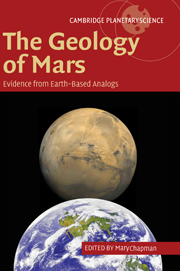Book contents
- Frontmatter
- Contents
- Preface: the rationale for planetary analog studies
- List of contributors
- 1 The geology of Mars: new insights and outstanding questions
- 2 Impact structures on Earth and Mars
- 3 Terrestrial analogs to the calderas of the Tharsis volcanoes on Mars
- 4 Volcanic features of New Mexico analogous to volcanic features on Mars
- 5 Comparison of flood lavas on Earth and Mars
- 6 Rootless volcanic cones in Iceland and on Mars
- 7 Mars interior layered deposits and terrestrial sub-ice volcanoes compared: observations and interpretations of similar geomorphic characteristics
- 8 Lava—sediment interactions on Mars: evidence and consequences
- 9 Eolian dunes and deposits in the western United States as analogs to wind-related features on Mars
- 10 Debris flows in Greenland and on Mars
- 11 Siberian rivers and Martian outflow channels: an analogy
- 12 Formation of valleys and cataclysmic flood channels on Earth and Mars
- 13 Playa environments on Earth: possible analogs for Mars
- 14 Signatures of habitats and life in Earth's high-altitude lakes: clues to Noachian aqueous environments on Mars
- 15 The Canyonlands model for planetary grabens: revised physical basis and implications
- 16 Geochemical analogs and Martian meteorites
- 17 Integrated analog mission design for planetary exploration with humans and robots
- Index
- Plate section
- References
17 - Integrated analog mission design for planetary exploration with humans and robots
Published online by Cambridge University Press: 18 September 2009
- Frontmatter
- Contents
- Preface: the rationale for planetary analog studies
- List of contributors
- 1 The geology of Mars: new insights and outstanding questions
- 2 Impact structures on Earth and Mars
- 3 Terrestrial analogs to the calderas of the Tharsis volcanoes on Mars
- 4 Volcanic features of New Mexico analogous to volcanic features on Mars
- 5 Comparison of flood lavas on Earth and Mars
- 6 Rootless volcanic cones in Iceland and on Mars
- 7 Mars interior layered deposits and terrestrial sub-ice volcanoes compared: observations and interpretations of similar geomorphic characteristics
- 8 Lava—sediment interactions on Mars: evidence and consequences
- 9 Eolian dunes and deposits in the western United States as analogs to wind-related features on Mars
- 10 Debris flows in Greenland and on Mars
- 11 Siberian rivers and Martian outflow channels: an analogy
- 12 Formation of valleys and cataclysmic flood channels on Earth and Mars
- 13 Playa environments on Earth: possible analogs for Mars
- 14 Signatures of habitats and life in Earth's high-altitude lakes: clues to Noachian aqueous environments on Mars
- 15 The Canyonlands model for planetary grabens: revised physical basis and implications
- 16 Geochemical analogs and Martian meteorites
- 17 Integrated analog mission design for planetary exploration with humans and robots
- Index
- Plate section
- References
Summary
Introduction
For reasons of cost and risk, planetary exploration since Apollo has been carried out by robots with the human input made from Earth. Given communication time delays and the manifest limitations of robots, the pace and quality of such exploration could be greatly improved if humans were more directly involved. Exploration continues using increasingly advanced robotic technologies including those intended to begin the subsurface exploration of the planets. Before such missions will be undertaken we need assurance that these new technologies work adequately under appropriate terrestrial analog conditions. Eventually, humans will re-enter the picture with in-depth exploration of the Moon and Mars as their principal focus. However, such human explorers will not be able to achieve the global reach needed to answer the many questions scientists pursue for a planet as large and diverse as Mars. So, how should humans and robots work together optimally? Can advanced robots tele-operated by humans at short light distances approach the scientific productivity of a trained, yet suit-encumbered, astronaut? To answer these questions, researchers must define scientific return and find ways to compare the productivity of different human–robot exploration systems. Analogs can be used to develop the full range of possible human and robotic exploration systems using metrics that allow us to quantify the effectiveness of each.
Some important outstanding exploration issues that high-fidelity analog missions can inform include:
Development, testing, and demonstration of exploration hardware, including surface habitats and extra-vehicular activity (EVA) systems.
Selection of landing sites that maximize access to resources and scientifically interesting terrain.
[…]
- Type
- Chapter
- Information
- The Geology of MarsEvidence from Earth-Based Analogs, pp. 424 - 456Publisher: Cambridge University PressPrint publication year: 2007
References
- 6
- Cited by



